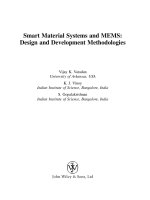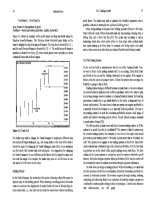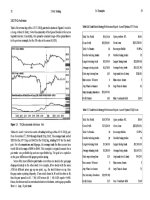EMBEDDED LINUX SYSTEM DESIGN AND DEVELOPMENT
Bạn đang xem bản rút gọn của tài liệu. Xem và tải ngay bản đầy đủ của tài liệu tại đây (6.42 MB, 429 trang )
Au0586 half title page 11/17/05 2:05 PM Page 1
E
MBEDDED
L
INUX
S
YSTEM
D
ESIGN AND
D
EVELOPMENT
TEAM FLY
Au0586 title page 11/17/05 2:04 PM Page 1
Boca Raton New York
E
MBEDDED
L
INUX
S
YSTEM
D
ESIGN AND
D
EVELOPMENT
P. Raghavan • Amol Lad • Sriram Neelakandan
Published in 2006 by
Auerbach Publications
Taylor & Francis Group
6000 Broken Sound Parkway NW, Suite 300
Boca Raton, FL 33487-2742
© 2006 by Taylor & Francis Group, LLC
Auerbach is an imprint of Taylor & Francis Group
No claim to original U.S. Government works
Printed in the United States of America on acid-free paper
10987654321
International Standard Book Number-10: 0-8493-4058-6 (Hardcover)
International Standard Book Number-13: 978-0-8493-4058-1 (Hardcover)
Library of Congress Card Number 2005048179
This book contains information obtained from authentic and highly regarded sources. Reprinted material is quoted with
permission, and sources are indicated. A wide variety of references are listed. Reasonable efforts have been made to publish
reliable data and information, but the author and the publisher cannot assume responsibility for the validity of all materials
or for the consequences of their use.
No part of this book may be reprinted, reproduced, transmitted, or utilized in any form by any electronic, mechanical, or
other means, now known or hereafter invented, including photocopying, microfilming, and recording, or in any information
storage or retrieval system, without written permission from the publishers.
For permission to photocopy or use material electronically from this work, please access www.copyright.com
( or contact the Copyright Clearance Center, Inc. (CCC) 222 Rosewood Drive, Danvers, MA
01923, 978-750-8400. CCC is a not-for-profit organization that provides licenses and registration for a variety of users. For
organizations that have been granted a photocopy license by the CCC, a separate system of payment has been arranged.
Trademark Notice: Product or corporate names may be trademarks or registered trademarks, and are used only for
identification and explanation without intent to infringe.
Library of Congress Cataloging-in-Publication Data
Raghavan, P. (Pichai), 1973-
Embedded Linux system design and development / P. Raghavan, Amol Lad, Sriram Neelakandan.
p. cm.
Includes bibliographical references and index.
ISBN 0-8493-4058-6 (alk. paper)
1. Linux. 2. Operating systems (Computers) 3. Embedded computer systems. I. Lad, Amol. II.
Neelakandan, Sriram. III. Title.
QA76.76.O63R335 2005
005.4'32--dc22 2005048179
Visit the Taylor & Francis Web site at
and the Auerbach Publications Web site at
Taylor & Francis Group
is the Academic Division of T&F Informa plc.
All source code in the book is released under GNU GPL v2. It can be used as desired under terms and
conditions of GNU GPL v2.
Trademarks
Ⅲ
MIPS is a registered trademark and YAMON is a trademark of MIPS Technologies.
Ⅲ
IBM and ClearCase are registered trademarks and PowerPC is a trademark of International Business
Machines Corporation.
Ⅲ
UNIX is a registered trademark in the United States and other countries, licensed exclusively through
X/Open Company Limited.
Ⅲ
X11 is a trademark of Massachusetts Institute of Technology.
Ⅲ
NEC is a registered trademark of NEC Corporation
Ⅲ
HP is a registered trademark of Hewlett-Packard Company.
Ⅲ
ColdFire is a registered trademark and Motorola is a trademark of Motorola, Inc
Ⅲ
Microblaze is trademark of Xilinx Inc
Ⅲ
Red Hat is a registered trademark and eCos and RedBoot are trademarks of Red Hat, Inc.
Ⅲ
uClinux is a registered trademark of Arcturus Networks Inc
Ⅲ
Linux is a registered trademark of Linus Torvalds
Ⅲ
GoAhead is a registered trademark of GoAhead Software, Inc
Ⅲ
RTLinux is a registered trademark and FSMLabs, RTLinuxPro and RTCore are trademarks of Finite State
Machine Labs, Inc
Ⅲ
Debian is a registered trademark of Software in the Public Interest, Inc
Ⅲ
LMBench is a trademark of BitMover, Inc
Ⅲ
VRTX is a trademark of Microtech Research Inc
Ⅲ
VxWorks and pSOS are registered trademarks of Wind River Systems, Inc
Ⅲ
Trolltech is registered trademark and Qt is a trademark of Trolltech in Norway, the United States and
other countries
Ⅲ
OpenGL is a registered trademark of Silicon Graphics, Inc
Ⅲ
Perforce is a registered trademark of Perforce Software, Inc
Ⅲ
Eclipse is trademark of Eclipse Foundation, Inc
Ⅲ
KDE and K Desktop Environment are trademarks of KDE
Ⅲ
FFmpeg is a trademark of Fabrice Bellard, originator of the FFmpeg project
Ⅲ
NVIDIA is a registered trademark of NVIDIA Corporation in the United States and other countries
Ⅲ
ViewML is a registered trademark of Century Software Inc
Ⅲ
QNX and Neutrino are registered trademarks of QNX Software Systems Ltd
Ⅲ
Nucleus is a trademark of Accelerated Technology, Inc
Ⅲ
Accelerated Technology is a registered trademark of Mentor Graphics Corporation
Ⅲ
ARM and StrongARM are registered trademarks and ARM7 and ARM9 are trademarks of Advanced RISC
Machines, Ltd.
Ⅲ
AMD is a registered trademark of Advanced Micro Devices, Inc.
Ⅲ
Intel and Pentium are registered trademarks and i386 and XScale are trademarks of Intel Corporation.
Ⅲ
Sharp is a registered trademark of Sharp Electronics Corp.
Ⅲ
SPARC is a registered trademark of SPARC International, Inc., and is used under license by Sun
Microsystems, Inc.
Ⅲ
Toshiba is a registered trademark of the Toshiba Corporation.
Ⅲ
MontaVista is registered trademark of MontaVista Software Inc.
Ⅲ
LynxOS and BlueCat are registered trademarks and LynuxWorks, SpyKer and VisualLynux are trademarks
of LynuxWorks, Inc.
Ⅲ
Samsung is a registered trademark of Samsung Electronics America, Inc. and its related entities.
Ⅲ
Ericsson is a registered trademark of Ericsson, Inc.
Ⅲ
Atmel is registered trademarks of Atmel Corporation.
Ⅲ
TimeSys
®
, TimeStorm®, TimeStorm IDE™, TimeStorm LVS™, TimeStorm LDS™, TimeStorm LHD™,
TimeSys Reservations™, TimeTrace
®
, Linux/RT
TM
and TimeWiz
®
are registered or unregistered trademarks
of TimeSys Corporation in the United States and other countries.
Ⅲ
NeoMagic is registered trademark of NeoMagic Corporation.
Ⅲ
Transmeta is a trademark of Transmeta Corporation.
Ⅲ
Broadcom is a registered trademark of Broadcom Corporation and/or its subsidiaries.
Ⅲ
SuSE is a registered trademark of SuSE AG.
vi
Embedded Linux System Design and Development
Ⅲ
Borland is a registered trademark of Borland Software Corporation in the United States and other
countries.
Ⅲ
Merant is a registered trademark of Merant.
Ⅲ
SnapGear is a registered trademark of SnapGear Inc.
Ⅲ
Matsushita is a trademark of the Matsushita Electric Corporation.
Ⅲ
I2C is a trademark of Philips Semiconductors Corporation.
Ⅲ
Philips® is a registered trademark of Philips Consumer Electronics Corporation.
Ⅲ
Cadenux is a trademark of Cadenux, LLC.
Ⅲ
ELinOS is a registered trademark of SYSGO AG.
Ⅲ
Metrowerks and CodeWarrior are trademarks of Metrowerks Corp. in the U.S. or other countries.
Ⅲ
FreeBSD is a registered trademark of the FreeBSD Foundation.
Ⅲ
IEEE and POSIX are registered trademarks of Institute of Electrical and Electronics Engineers, Inc. in
the United States.
Ⅲ
Xtensa is a trademark belonging to Tensilica Inc.
Ⅲ
Fujitsu is a registered trademark of Fujitsu, Ltd.
Ⅲ
Firewire is a registered trademark of Apple computer.
Ⅲ
SuperH is a trademark of Hitachi, Ltd.
Ⅲ
Windows, WinCE and Microsoft are registered trademarks and MS-DOS and DirectX .are trademarks of
Microsoft Corporation.
Ⅲ
Solaris and Java are registered trademarks and ChorusOS is a trademark of Sun Microsystems, Inc. in
the U.S. or other countries.
Ⅲ
Symbian is a trademark of Symbian Ltd.
vii
Dedication
Raghavan
In memory of my late father
Amol
To Lord Krsna,
...
my parents, my wife Parul, and my brother Amit
Sriram
To my family and all Linux enthusiasts
ix
Contents
1
Intr oduction ............................................................................................. 1
1.1 History of Embedded Linux .................................................... 2
1.1.1 Year 1999 ..................................................................... 3
1.1.2 Year 2000 ..................................................................... 4
1.1.3 Year 2001 ..................................................................... 4
1.1.4 Year 2002 ..................................................................... 5
1.1.5 Year 2003 ..................................................................... 6
1.1.6 Year 2004 ..................................................................... 6
1.2 Why Embedded Linux? ............................................................ 7
1.2.1 Vendor Independence................................................. 7
1.2.2 Time to Market............................................................ 8
1.2.3 Varied Hardware Support ........................................... 8
1.2.4 Low Cost ...................................................................... 8
1.2.5 Open Source................................................................ 9
1.2.6 Standards (POSIX®) Compliance............................. 10
1.3 Embedded Linux Versus Desktop Linux .............................. 10
1.4 Frequently Asked Questions.................................................. 11
1.4.1 Is Linux Too Large?................................................... 11
1.4.2 Is Linux Real-Time Enough?..................................... 11
1.4.3 How Can I Protect My Proprietary Software?......... 12
1.4.4 Should I Buy a Commercial Embedded
Linux Distribution?..................................................... 12
1.4.5 Which Embedded Linux Distribution Do I
Choose? ...................................................................... 12
1.5 Embedded Linux Distributions .............................................. 13
1.5.1 BlueCat Linux ............................................................ 14
1.5.2 Cadenux ..................................................................... 15
1.5.3 Denx........................................................................... 17
x Embedded Linux System Design and Development
1.5.4 Embedded Debian (Emdebian)................................ 18
1.5.5 ELinOS (SYSGO) ....................................................... 19
1.5.6 Metrowerks ................................................................ 20
1.5.7 MontaVista Linux....................................................... 22
1.5.8 RTLinuxPro™ ............................................................. 23
1.5.9 TimeSys Linux............................................................ 24
1.6 Porting Roadmap .................................................................... 26
Notes ................................................................................................. 28
2
Getting Started ........................................................................................ 29
2.1 Architecture of Embedded Linux .......................................... 29
2.1.1 Real-Time Executive.................................................. 29
2.1.2 Monolithic Kernels .................................................... 30
2.1.3 Microkernel ................................................................ 31
2.2 Linux Kernel Architecture...................................................... 32
2.2.1 Hardware Abstraction Layer (HAL).......................... 33
2.2.2 Memory Manager....................................................... 33
2.2.3 Scheduler.................................................................... 34
2.2.4 File System................................................................. 35
2.2.5 IO Subsystem............................................................. 36
2.2.6 Networking Subsystems ............................................ 36
2.2.7 IPC .............................................................................. 36
2.3 User Space .............................................................................. 36
2.4 Linux Start-Up Sequence........................................................ 41
2.4.1 Boot Loader Phase .................................................... 42
2.4.2 Kernel Start-Up .......................................................... 43
2.4.3 User Space Initialization ........................................... 47
2.5 GNU Cross-Platform Toolchain ............................................. 48
2.5.1 Building Toolchain .................................................... 50
2.5.2 Building Toolchain for MIPS .................................... 55
3
Boar d Support Package ......................................................................... 59
3.1 Inserting BSP in Kernel Build Procedure............................. 60
3.2 The Boot Loader Interface..................................................... 62
3.3 Memory Map........................................................................... 66
3.3.1 The Processor Memory Map — MIPS Memory
Model.......................................................................... 67
3.3.2 Board Memory Map .................................................. 68
3.3.3 Software Memory Map.............................................. 68
3.4 Interrupt Management............................................................ 72
3.5 The PCI Subsystem................................................................. 77
3.5.1 Uniqueness of PCI Architecture............................... 77
3.5.2 PCI Software Architecture......................................... 79
Contents xi
3.6 Timers...................................................................................... 81
3.7 UART ....................................................................................... 81
3.7.1 Implementing the Console ....................................... 81
3.7.2 The KGDB Interface ................................................. 82
3.8 Power Management................................................................ 83
3.8.1 Hardware and Power Management ......................... 83
3.8.2 Power Management Standards ................................. 85
3.8.3 Supporting Processor’s Power-Saving Modes ......... 86
3.8.4 Unified Driver Framework for Power
Management............................................................... 87
3.8.5 Power Management Applications............................. 88
4
Embedded Storage ................................................................................. 89
4.1 Flash Map................................................................................ 89
4.2 MTD—Memory Technology Device...................................... 91
4.2.1 The MTD Model ........................................................ 91
4.2.2 Flash Chips ................................................................ 92
4.2.3 Flash Disks................................................................. 92
4.3 MTD Architecture ................................................................... 94
4.3.1
mtd_info
Data Structure ......................................... 96
4.3.2 Interface Between MTD Core and Low-Level
Flash Drivers.............................................................. 96
4.4 Sample MTD Driver for NOR Flash...................................... 97
4.5 The Flash-Mapping Drivers ................................................. 106
4.5.1 Filling up
mtd_info
for NOR Flash Chip ............ 106
4.5.2 Filling up
mtd_info
for NAND Flash Chip ......... 108
4.5.3 Registering
mtd_info
.............................................. 109
4.5.4 Sample Mapping Driver for NOR Flash ................ 111
4.6 MTD Block and Character Devices..................................... 114
4.7 Mtdutils Package................................................................... 116
4.8 Embedded File Systems ....................................................... 116
4.8.1 Ramdisk.................................................................... 117
4.8.2 RAMFS ...................................................................... 117
4.8.3 CRAMFS (Compressed RAM File System) ............. 117
4.8.4 Journaling Flash File Systems — JFFS and
JFFS2......................................................................... 117
4.8.5 NFS — Network File System.................................. 119
4.8.6 PROC File System.................................................... 119
4.9 Optimizing Storage Space.................................................... 120
4.9.1 Kernel Space Optimization..................................... 120
4.9.2 Application Space Optimization............................. 121
4.9.3 Applications for Embedded Linux ......................... 122
4.10 Tuning Kernel Memory........................................................ 124
xii Embedded Linux System Design and Development
5
Embedded Drivers ............................................................................... 127
5.1 Linux Serial Driver................................................................ 128
5.1.1 Driver Initialization and Start-Up ........................... 130
5.1.2 Data Transmission ................................................... 134
5.1.3 Data Reception ........................................................ 134
5.1.4 Interrupt Handler..................................................... 134
5.1.5 Terminos Settings .................................................... 138
5.2 Ethernet Driver ..................................................................... 138
5.2.1 Device Initialization and Clean-Up........................ 140
5.2.2 Data Transmission and Reception ......................... 142
5.3 I2C Subsystem on Linux ...................................................... 144
5.3.1 I2C Bus..................................................................... 145
5.3.2 I2C Software Architecture....................................... 147
5.4 USB Gadgets ......................................................................... 152
5.4.1 USB Basics ............................................................... 153
5.4.2 Ethernet Gadget Driver........................................... 158
5.5 Watchdog Timer ................................................................... 161
5.6 Kernel Modules..................................................................... 162
5.6.1 Module APIs ............................................................ 162
5.6.2 Module Loading and Unloading ............................ 164
Notes ............................................................................................... 164
6
Porting Applications ............................................................................ 165
6.1 Architectural Comparison..................................................... 165
6.2 Application Porting Roadmap.............................................. 166
6.2.1 Decide Porting Strategy .......................................... 167
6.2.2 Write an Operating System Porting Layer
(OSPL) ...................................................................... 169
6.2.3 Write a Kernel API Driver ...................................... 170
6.3 Programming with Pthreads ................................................ 171
6.3.1 Thread Creation and Exit ....................................... 172
6.3.2 Thread Synchronization .......................................... 174
6.3.3 Thread Cancellation ................................................ 180
6.3.4 Detached Threads ................................................... 181
6.4 Operating System Porting Layer (OSPL)............................. 182
6.4.1 RTOS Mutex APIs Emulation.................................. 182
6.4.2 RTOS Task APIs Emulation .................................... 185
6.4.3 IPC and Timer APIs Emulation .............................. 191
6.5 Kernel API Driver................................................................. 191
6.5.1 Writing User-Space Stubs........................................ 194
6.5.2 Kapi Driver Implementation................................... 195
6.5.3 Using the Kapi Driver............................................. 199
Note................................................................................................. 200
Contents xiii
7
Real-Time Linux ................................................................................... 201
7.1 Real-Time Operating System ............................................... 202
7.2 Linux and Real-Time ............................................................ 202
7.2.1 Interrupt Latency ..................................................... 203
7.2.2 ISR Duration ............................................................ 204
7.2.3 Scheduler Latency.................................................... 205
7.2.4 Scheduler Duration.................................................. 207
7.2.5 User-Space Real-Time ............................................. 209
7.3 Real-Time Programming in Linux ....................................... 209
7.3.1 Process Scheduling.................................................. 210
7.3.2 Memory Locking...................................................... 213
7.3.3 POSIX Shared Memory ........................................... 223
7.3.4 POSIX Message Queues.......................................... 225
7.3.5 POSIX Semaphores.................................................. 232
7.3.6 Real-Time Signals .................................................... 233
7.3.7 POSIX.1b Clock and Timers................................... 241
7.3.8 Asynchronous I/O ................................................... 246
7.4 Hard Real-Time Linux .......................................................... 252
7.4.1 Real-Time Application Interface (RTAI)................. 253
7.4.2 ADEOS...................................................................... 258
8
Building and Debugging ...................................................................... 261
8.1 Building the Kernel .............................................................. 263
8.1.1 Understanding Build Procedure............................. 265
8.1.2 The Configuration Process...................................... 266
8.1.3 Kernel Makefile Framework ................................... 268
8.2 Building Applications ........................................................... 270
8.2.1 Cross-Compiling Using Configure.......................... 273
8.2.2 Troubleshooting Configure Script .......................... 274
8.3 Building the Root File System............................................. 275
8.4 Integrated Development Environment................................ 278
8.4.1 Eclipse ...................................................................... 279
8.4.2 KDevelop ................................................................. 279
8.4.3 TimeStorm ................................................................ 279
8.4.4 CodeWarrior ............................................................. 280
8.5 Debugging Virtual Memory Problems ................................ 280
8.5.1 Debugging Memory Leaks...................................... 282
8.5.2 Debugging Memory Overflows.............................. 286
8.5.3 Debugging Memory Corruption ............................. 287
8.6 Kernel Debuggers................................................................. 291
8.7 Profiling ................................................................................. 293
8.7.1 eProf—An Embedded Profiler................................ 294
8.7.2 OProfile .................................................................... 300
xiv Embedded Linux System Design and Development
8.7.3 Kernel Function Instrumentation ........................... 302
Notes ............................................................................................... 308
9
Embedded Graphics ............................................................................. 309
9.1 Graphics System ................................................................... 309
9.2 Linux Desktop Graphics—The X Graphics System........... 311
9.2.1 Embedded Systems and X...................................... 312
9.3 Introduction to Display Hardware ...................................... 313
9.3.1 Display System ........................................................ 313
9.3.2 Input Interface ......................................................... 316
9.4 Embedded Linux Graphics .................................................. 316
9.5 Embedded Linux Graphics Driver ...................................... 316
9.5.1 Linux Frame Buffer Interface ................................. 317
9.5.2 Frame Buffer Internals ............................................ 326
9.6 Windowing Environments, Toolkits, and Applications ..... 328
9.6.1 Nano-X ..................................................................... 335
9.7 Conclusion............................................................................. 340
Notes ............................................................................................... 340
10
uClinux ................................................................................................. 341
10.1 Linux on MMU-Less Systems............................................... 341
10.1.1 Linux Versus uClinux .............................................. 342
10.2 Program Load and Execution.............................................. 343
10.2.1 Fully Relocatable Binaries (FRB)............................ 345
10.2.2 Position Independent Code (PIC).......................... 345
10.2.3 bFLT File Format ..................................................... 346
10.2.4 Loading a bFLT File ................................................ 347
10.3 Memory Management........................................................... 358
10.3.1 Heap ......................................................................... 358
10.3.2 Stack ......................................................................... 363
10.4 File / Memory Mapping—The Intricacies of mmap( )
in uClinux ............................................................................. 364
10.5 Process Creation ................................................................... 365
10.6 Shared Libraries .................................................................... 367
10.6.1 uClinux Shared Library Implementation
(libN.so).................................................................... 367
10.7 Porting Applications to uClinux.......................................... 370
10.7.1 Creating uClinux Programs..................................... 370
10.7.2 Creating Shared Libraries in uClinux..................... 371
10.7.3 Using Shared Library in an Application ................ 373
10.7.4 Memory Limitations................................................. 375
10.7.5 mmap Limitations .................................................... 375
10.7.6 Process-Level Limitations ........................................ 375
Contents xv
10.8 XIP—eXecute In Place......................................................... 375
10.8.1 Hardware Requirements ......................................... 377
10.8.2 Software Requirements ........................................... 378
10.9 Building uClinux Distribution.............................................. 378
Notes ............................................................................................... 380
Appendices
A
Booting Faster ...................................................................................... 383
Techniques for Cutting Down Bootloader Initialization............. 384
Tuning Kernel for Decreased Boot-Up Time .............................. 385
Tuning User Space for Decreased Boot-Up Time ...................... 385
Measuring Boot-Up Time .............................................................. 386
B
GPL and Embedded Linux ................................................................... 387
User-Space Applications ................................................................ 387
Kernel.............................................................................................. 388
Points to Remember ...................................................................... 389
Notes ............................................................................................... 390
Index
............................................................................................................ 391









